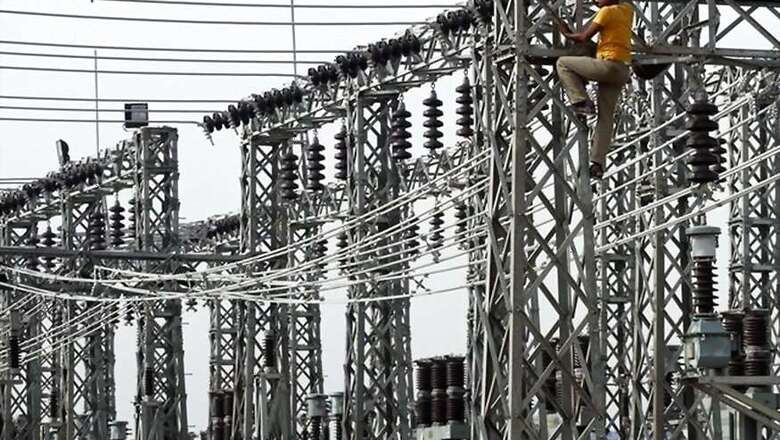
views
New Delhi: “India is moving from power shortage to power surplus, network failure to exporter. We have also moved towards 'One Nation, One Grid'." The Prime Minister was justifiably proud of his government’s achievements in the power sector when he rose to speak at the News18 ‘Rising India’ summit in New Delhi on Friday.
The NDA government has indeed racked up a series of creditable goals in the sector — be it electrification of villages, getting a power connection to each household or the move to end the monopoly of Coal India, which could unleash the full potential of India’s coal-fired power plants. But if there is renewed hope for this benighted sector, it would be wishful thinking to believe it is out of the dark completely.
India is now generating surplus power and has moved from being a country perennially short on power to one which generates adequate amounts not just for domestic consumption but also for exports. Growth in power generation (cumulative annual growth rate CAGR) was 6.1% under the UPA reign at the Centre from 2004-14 and grew to 6.8% from 2014-2017 under the NDA. With robust growth in generation capacity, energy shortage has reduced from 42,428 MU (4.2%) in 2014 to 7,459 MU in 2017 (0.7%). In other words, energy shortage has become negligible during the NDA regime.
Consequently, peak demand shortage has almost reduced to a third, from 6,103 MW (4.5%) in 2014 to 2,608 MW (1.6%) in 2017. India has turned around from a net importer of electricity to net exporter, exporting around 5,798 million units to Nepal, Bangladesh and Myanmar in 2017.
But the power sector is facing several challenges as well.
First, the NDA government has slashed allocation to the Ministry of Power by half in the Budget for 2018-19 to Rs 15,046.92 crore (against a demand for Rs 36843.32 crore) and this is sure to adversely impact ambitious flagship sector schemes such as those for electrifying each village, getting electricity to each Indian household, improving electricity distribution, etc. While it is true that many ministries have been allocated far less than what they sought in the Budget for next fiscal and the power sector is not the only one facing a money crunch. But if the government wants to adhere to its own targets, it must allocate adequate funds for power sector schemes. For example, the Deen Dayal Upadhyay Gram Jyoti Mission which highlights rural electrification improvements, has seen meagre allocation of funds and will likely suffer.
Second, though there has been rapid reduction in the number of un-electrified villages under the NDA push, still 1,234 such villages remained without electricity till January this year, according to data provided by the ministry of power to a Parliamentary Standing Committee while presenting its demand for grants for 2018-19. These villages are located in remote and rather inaccessible areas and the committee expressed doubts over whether the target of electrifying all villages in India by May 2018 would be achieved as per the deadline.
Third, over and above the target of electrifying all villages, another ambitious scheme of the NDA government targets providing an electricity connection to each and every household in India by March 2019 under the ‘Saubhagya’ scheme. This is also unlikely to be achieved, according to the Committee.
Fourth, and perhaps the most troublesome part of rapid power generation capacity increase, is the quantum jump in stressed assets in the sector and consequent challenges for India’s public sector banks, which hold considerable exposure to this. According to a report of another standing committee titled ‘Stressed, non-performing assets in electricity sector’, which was tabled in Parliament recently, Rs 174, 468 lakh crore is the debt outstanding from 34 stressed power sector assets of private power producers. A power surplus situation today has meant that much of the installed capacity of these plants remain idle – from nearly 80% of the capacity being used in 2006-07, the utilisation had fallen to just 60% by 2016-17.
Non-availability of regular fuel supply arrangements, lack of Power Purchase Agreements (PPA), inability of the promoters to infuse equity and working capital and other regulatory and contractual issues were some of the reasons for rising stress in the power sector. The total advances towards electricity generation sector by scheduled commercial banks stand at about Rs. 4.71 lakh crore.
Four companies of Lanco group owe banks a whopping Rs 23,591 crore in unpaid debt; two companies of the Adani group owe Rs 14,864 crore, Jaypee Power Venture (Bara) owes Rs 114,93.5 crore; three companies of the GMR Group together owe Rs 15,178.9 crore and the Essar group has unpaid loans totalling Rs 9063 crore for two projects.
The power sector has seen tremendous growth in terms of capacity addition during last few years. During Twelfth Plan period, cumulative capacity addition of 99,209.5 MW was achieved against target of 88,537 MW. The share of private sector in overall installed capacity has grown from just 13% in March 2007 to 44% in March, 2017. In other words, the contribution of the private sector has grown by a third in a decade. During the last ten years, the public sector (both Centre and state combined) contributed 73,402 MW while private sector alone contributed 77,891 MW capacity addition.
This expansion in power generation is a good idea as long as it is done without stressing out the banks and it leads to fulfillment of village electrification targets and those set for providing connections to each household. The power sector needs funds and strong policy initiatives to keep up the momentum.
(The author is senior journalist. Views are personal)


















Comments
0 comment